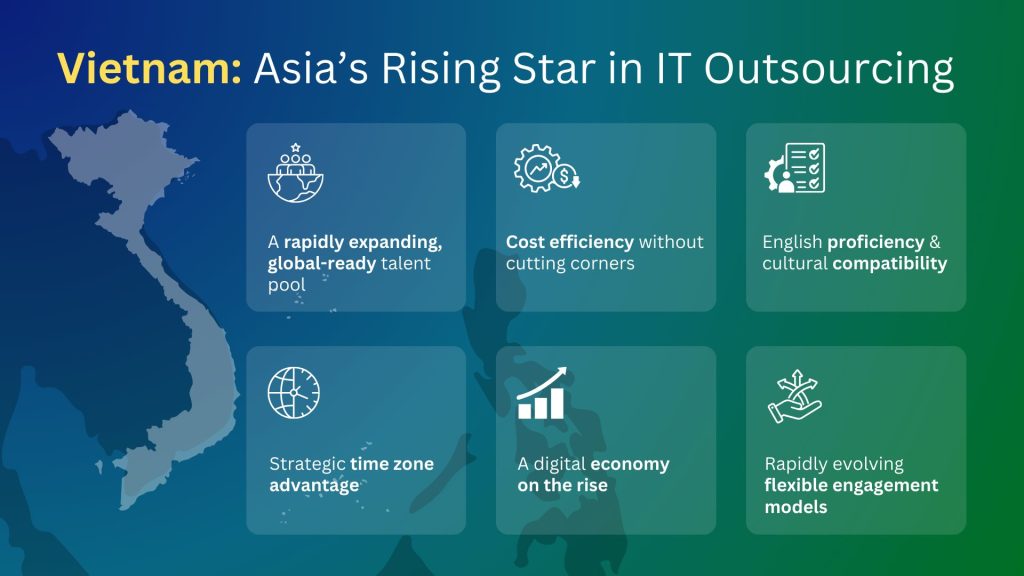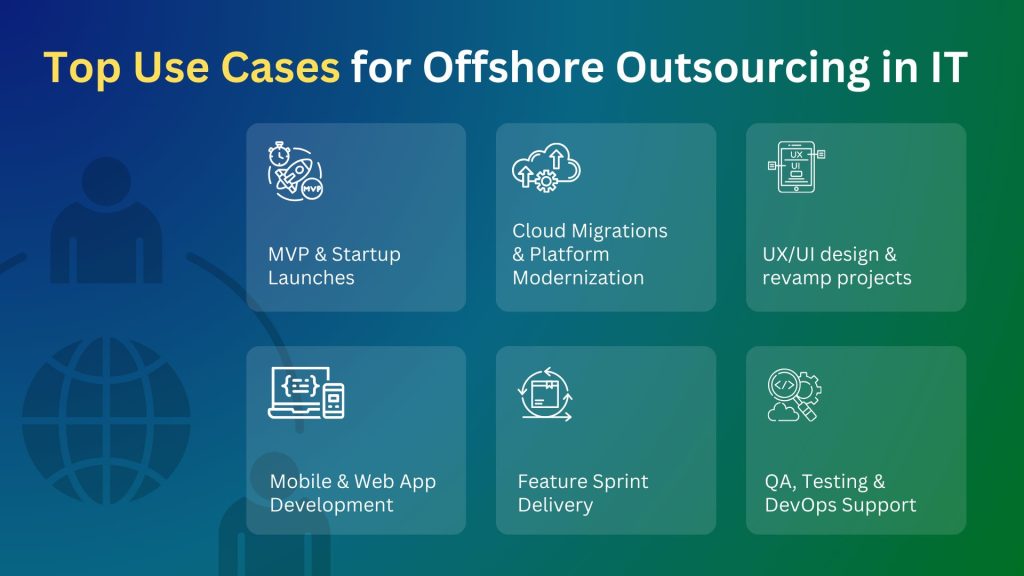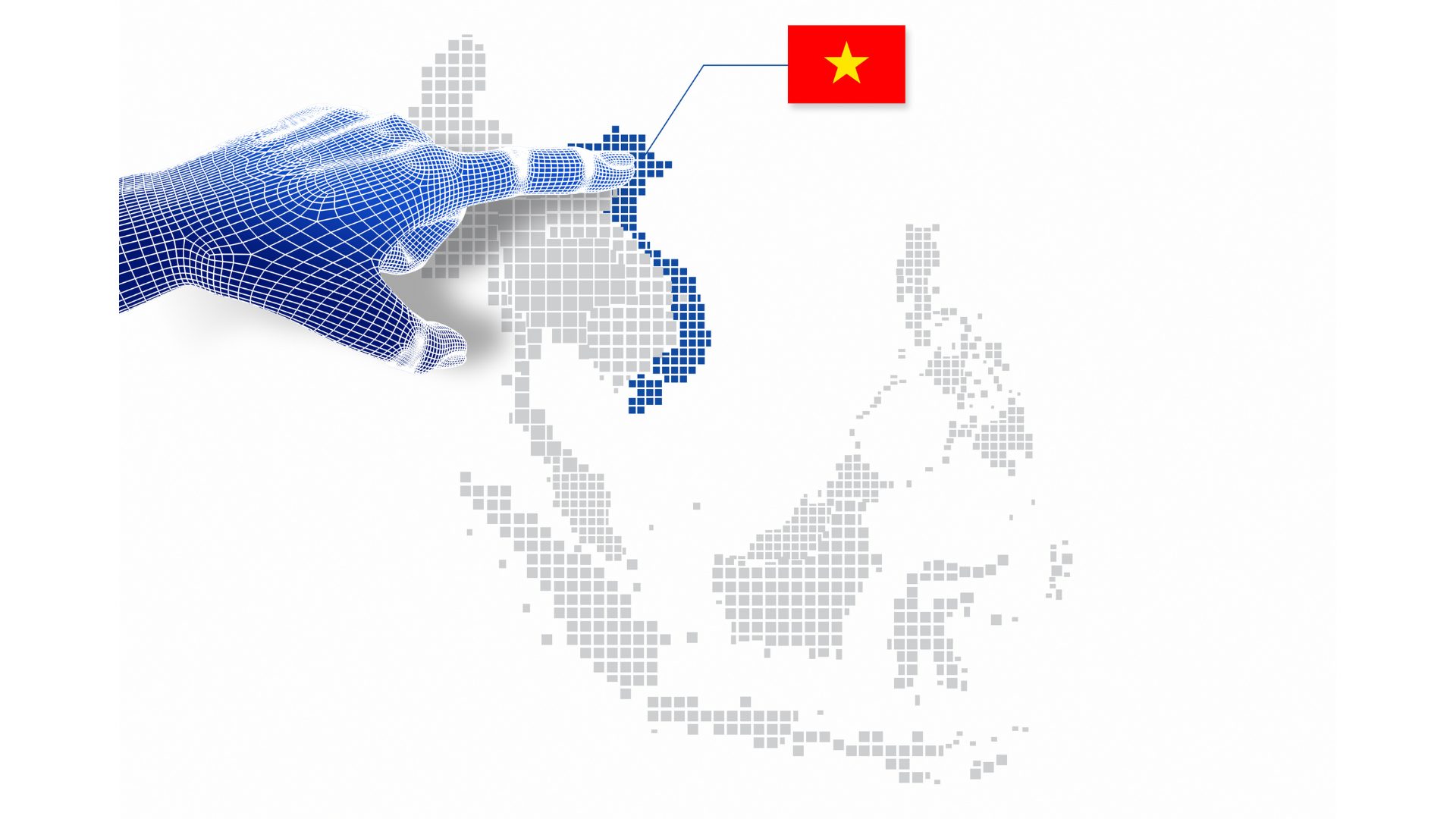
The IT Outsourcing Dilemma Facing Global Businesses
The global tech landscape is reaching a turning point. In 2024, about 1.7 million tech jobs were open worldwide: 438,000 in the United States, 960,000 in Europe and 350,000 in Japan, with further demand from Israel, Canada, India, Brazil, Australia and more. By 2030, the shortage of ICT specialists is expected to exceed 8 million (European Commission 2023). Meanwhile, the rise of advanced technologies, especially cloud and AI, has made digital transformation a business imperative. As a result, many companies are turning to IT outsourcing in Vietnam and other global hubs to address the widening talent gap.
The industry is no longer “a rich land” where talent easily finds jobs and businesses easily secure results. From startups to Fortune 500 companies, IT leaders around the world are facing the same dilemma: “Where can I find reliable, cost-effective, high-quality developers fast?”
For years, offshore destinations like India, Eastern Europe, and the Philippines dominated the outsourcing conversation. But in 2025, a new global player has entered the spotlight – Vietnam. Fueled by a deep talent pool, robust digital infrastructure and competitive costs, many companies are now considering outsourcing to Vietnam to meet rising needs (Dirox 2025).
Whether you’re a CTO in the U.S., a startup founder in Singapore, or a project lead in the UAE, exploring offshore development isn’t just about cutting costs, it’s about accessing global-ready tech talent that can accelerate product delivery and innovation.
What Business Leaders Should Consider Before IT Outsourcing
Offshore software development is becoming an essential way for companies to manage cost, speed and innovation. With digital transformation moving fast and tech talent in short supply, many businesses turn to overseas teams to get work done more efficiently. IT outsourcing can bring real advantages, but it also comes with challenges. Here’s a straightforward look at the pros and cons decision-makers should consider before choosing an approach.

The Pros
- Cost Efficiency
Labor cost savings are one of the most cited benefits. Outsourcing allows companies to tap into global markets where engineering salaries and operational costs are significantly lower than in North America, Western Europe, or other high-cost economies. These savings can range from 30% to 70% depending on the country and level of expertise required. - Access to Global Talent
Outsourcing provides access to a vast pool of skilled developers and specialists in markets with strong technical education systems. It’s especially useful for overcoming domestic talent shortages or filling niche technical roles. - Scalability and Speed
Outsourced teams allow businesses to ramp up development quickly, particularly in agile environments where speed-to-market is critical. It reduces lead times for hiring and onboarding, often helping to kick-start projects within weeks. - 24/7 Development Cycle
Time zone differences enable continuous development through “follow-the-sun” models. While your onshore team rests, your outsourced team progresses the work, effectively accelerating delivery timelines. - Focus on Core Competencies
Outsourcing technical execution frees up internal teams to focus on business strategy, product innovation, and customer experience – rather than being bogged down by development bottlenecks.
The Cons
- Communication Barriers
Different languages, communication styles, and time zones can cause misunderstandings, misaligned expectations, and delays. This is especially true if project management and documentation are weak. - Quality Control
The perceived quality gap is a common concern. Without strong oversight or experienced partners, offshoring may result in inconsistent code quality, technical debt, or rework costs. - Security and IP Risk
Data privacy laws vary across jurisdictions. If proper legal frameworks, NDAs, and cybersecurity protocols are not in place, offshore partnerships could increase exposure to data leaks or intellectual property theft. - Cultural and Work Ethic Differences
Differences in business culture, such as approaches to deadlines, hierarchy, and decision-making can affect collaboration and team dynamics. - Onboarding and Integration
Outsourced teams often lack the context of internal stakeholders, products, or legacy systems. Time must be invested in knowledge transfer, tool alignment, and process synchronization.
Why IT Outsourcing in Vietnam Is Asia’s Rising Star
IT outsourcing in Vietnam is gaining global traction. The country combines affordable, skilled talent, strong universities, improving English proficiency, and a fast-growing digital economy. For businesses looking to scale efficiently, software outsourcing in Vietnam offers not only cost savings but also long-term value through quality, flexibility and strategic time zone advantages.

1. A Rapidly Expanding, Global-Ready Talent Pool
Vietnam is building a world-class tech talent pool, with graduates earning global recognition through international competitions. Vietnamese IT teams have recently won the Gold Award at the Global AI Challenge, outperforming 200+ teams from 26 countries, and secured first place for the second time at Pwn2Own 2024, one of the world’s toughest hacking contests. Together, these achievements show that Vietnam’s developers are not just skilled locally – they’re ready to compete globally.
This progress is supported by a strong education system that prepares graduates for international standards. RMIT University Vietnam, ranked among the world’s top 125 in the QS World University Rankings, is recognized for sustainability, research, and graduates thousands of IT and software professionals each year. The country also has FPT University, founded by FPT Corporation – Vietnam’s largest IT services company with a presence in more than 25 countries. Its practice-driven curriculum and global network give students hands-on skills and the ability to contribute immediately in international environments.
Building on this foundation, Vietnam’s digital workforce is expanding rapidly, with more than 50,000 IT graduates each year. They are skilled in programming languages such as JavaScript, Python, Java, and .NET, experienced with cloud platforms like AWS, Azure, and Google Cloud, and often Agile-trained to integrate seamlessly into global development teams.
2. Cost Efficiency Without Cutting Corners
IT outsourcing from Vietnam offers unparalleled cost-value in the offshore IT landscape. Software developers here typically charges $15–20/hour for junior roles, $20–30/hour for mid-tier, and $25–35/hour for senior engineers. These rates are up to 50% lower than India or the Philippines, and far more cost-effective than China.
What sets Vietnam apart is that cost savings don’t come at the expense of quality. Graduates come from rigorous programs, many aligned with international accreditation and modern curricula. Employers benefit from lower salary outlay, while the higher standards of training help maintain technical excellence.
The government is also supporting the digital economy with tech parks, favorable policies, and fast-developing infrastructure. These initiatives make it easier for companies to onboard talent, integrate smoothly, and scale quickly. For many businesses, partnering with a software outsourcing company in Vietnam is as much about reliable talent quality as it is about cost efficiency.
3. English Proficiency & Cultural Compatibility
Vietnam’s rising role as an outsourcing hub is underpinned by improving English skills and cultural connectivity. According to the 2024 EF English Proficiency Index, Vietnam ranks 63rd globally and 8th in Asia. A significant number of Vietnamese IT students benefit from participating in technical English curricula, engaging in international exchange programs, and establishing partnerships with renowned global universities. These practices effectively enhance both language proficiency and cross-cultural adaptability.
The foundation in communication is significantly enhanced through practical exposure to Agile methodologies and global collaboration models during education and internships. Therefore, teams in Vietnam are equipped to effectively interpret specifications, engage in real-time problem-solving, and adhere to sprint rhythms, which helps reduce the friction typically associated with offshore workflows.
4. Strategic Time Zone Advantage
Located in GMT+7, Vietnam offers powerful time zone overlap with key global markets. You get
- full-day alignment with Southeast Asia and the UAE, 3–6 hour collaboration windows with Europe
- practical “follow-the-sun” cycles for development handoffs with U.S. teams.
This enables real-time daily standups, iterative delivery, and minimal delay, enhancing Agile and DevOps workflows. This overlap is why many teams choose software outsourcing to Vietnam for faster feedback loops and continuous delivery. With Vietnam, you establish a partnership that’s both synchronized and seamless.
5. A Digital Economy on the Rise
Vietnam’s digital economy is experiencing explosive growth, projected to reach $45 billion by 2025, up from $23 billion in 2022. Ambitiously, the government aims to raise digital contributions to 30% of GDP by 2030 and 50% by 2045 (ITA 2024). Concurrently, ICT revenue reached $165.9 billion in 2024, including over a thousand tech firms and more than 1.5 million ICT workers nationwide (https://www.vietnam-briefing.com).
This isn’t happenstance, it stems from aggressive public-private initiatives, digital-first policy frameworks, and surging demand in verticals like fintech, AI, and cloud services. As such, Vietnam today is a hotbed for digital innovation – not just a cost base, but a dynamic ecosystem of tech opportunity.
6. Rapidly Evolving Flexible Engagement Models
Vietnam is fast catching up to, and in many ways surpassing other markets by offering a diverse array of flexible engagement models you can tap into today:
- Dedicated Developers: Virtual team members who integrate fully into your in-house structure, working under your supervision and processes.
- Agile Offshore Squads: Self-organized groups familiar with cross-functional sprint workflows, ready to deliver product increments at scale.
- Project-Based Teams: Expert-driven units assembled for short-term or milestone-based deliverables, ideal for feature releases and MVPs.
- RaaS (Resource-as-a-Service): Vietnam’s standout model offering monthly-flexible scaling, moving seamlessly from 1 to 10 engineers based on demand, with rapid deployment in under two weeks. It is also a common entry point for software outsourcing to Vietnam.
This maturity and adaptability make IT outsourcing from Vietnam a standout choice for startups, scale-ups, and enterprise ventures looking to pivot quickly, without the overhead or inertia of traditional outsourcing relationships.
For more on how Resource-as-a-Service (RaaS) supports IT outsourcing, check out our blog: RaaS for IT Staff Augmentation: When and Why You Need It.
Top Use Cases for IT Outsourcing from Vietnam

Apart from understanding the advantages, risks, and Vietnam’s growing role in the market, it’s equally important to look at how businesses are applying outsourcing in practice. Let’s look at practical examples where outsourcing brings clear value to companies of all sizes.
1. MVP & Startup Launches
For startups, time and money are always tight. Outsourcing helps founders get an MVP up and running quickly, often in as little as 10 weeks, without burning through all their funds.
A fintech startup, for example, outsourced its Banking-as-a-Service MVP using Java, Spring Boot, and Kafka. This approach achieved over 70% cost reduction in development and infrastructure while facilitating a market launch within a few months.
2. Cloud Migrations & Platform Modernization
Many mid-size and enterprise companies still rely on outdated systems. According to IDC, by 2025, 60% of infrastructure, security, data, and network offerings will require cloud-based control platforms that enable extensive automation and deliver significant reductions in ongoing operations costs in 2025, driving demand for skilled cloud engineers globally (IDC FutureScape 2023).
Outsourcing brings in cloud specialists who can migrate workloads, modernize platforms, and keep operations compliant on AWS, Azure, or GCP. This way, businesses speed up their transformation without overwhelming internal teams.
3. UX/UI Design & Revamp Projects
Outsourced UI/UX designers can help revamp customer-facing apps and websites, especially for companies aiming to scale across regions. Partnering through software outsourcing to Vietnam is increasingly popular for design-driven projects, many Vietnam-based design teams are trained in Figma, Adobe XD, and user-centered design principles.
According to Forrester, companies that prioritize UX see a 400% increase in conversion rates (Forrester Research). In other words, better design directly translates into higher customer satisfaction and stronger business outcomes.
4. Mobile & Web App Development
Today’s users expect smooth digital experiences across devices. From custom web portals to cross-platform mobile apps, outsourced development teams are highly experienced in modern frameworks like React Native, ReactJS, Flutter, Node.js, and Next.js. This use case is ideal for companies scaling B2C platforms.
As of 2024, over 70% of web traffic globally comes from mobile devices (statcounter 2025). Companies prioritizing responsive design gain a competitive edge.
5. Feature Sprint Delivery
Even well-staffed internal teams can get stuck with growing feature backlogs. Outsourcing lets companies bring in developers or QA engineers on a per-feature basis to clear bottlenecks and keep up with demand. Flexible models such as Resource-as-a-Service (RaaS) make it simple to scale resources up or down as needed.
This flexible model is ideal for fast-moving Agile teams needing short-term scale without long-term commitments.
Find the best Raas model for your business here: Các mô hình thuê ngoài IT: Đâu là lựa chọn phù hợp nhất cho doanh nghiệp của bạn
6. QA, Testing & DevOps Support
Testing often becomes a bottleneck when scaling. Outsourced QA teams can perform automated, regression, and performance testing, while DevOps engineers ensure CI/CD pipelines, monitoring, and deployment stability.
GitLab’s 2023 DevSecOps survey shows that teams with full-time QA and DevOps support are 33% more likely to meet sprint goals. You can use IT outsourcing at specific stages, like UX design, testing, or cloud infrastructure and expand later, as long as it stays aligned with your business goals to avoid delays.
How to Choose the Right Software Outsourcing Company from Vietnam

The success of your outsourcing strategy depends on the partner you choose, not just the location. With the right team, you gain more than savings; you also get long-term strategic capacity, faster delivery, and support for innovation.
But not all outsourcing providers are created equal. Here’s how to evaluate your options and make the right decision:
1. Track Record & Case Studies
A credible partner should have verifiable experience in your domain or tech stack. Ask for:
- Portfolio of past projects
- Client testimonials
- Case studies in industries similar to yours
2. Technical Capability & Talent Bench
Dig into their core technical strengths:
- Do they have certified developers in your target stacks (e.g., Azure, React, Python)?
- Can they scale quickly if you need to grow from 3 to 15 engineers?
Evaluate the overall talent pool, including both active teams and potential candidates available for deployment. According to Accelerance 2024, 47% of outsourcing losses occur due to mismatches in capabilities, rather than pricing considerations.
3. Communication & Collaboration Fit
However, while fluency in English is important, what matters even more is how the partner communicates:
- Do they use modern Agile tools (Jira, Slack, Notion)?
- Are they comfortable with daily standups and async updates?
- Can they operate across time zones?
4. Security & Compliance Standards
Your partner should treat your IP and client data with the same care you do. Ask about:
- NDAs and IP protection agreements
- Certifications (ISO 27001, GDPR readiness, etc.)
5. Flexible Engagement Models
A strong partner understands your evolving needs. Look for flexibility:
- Can you scale up or down monthly?
- Can you switch between project-based and dedicated models?
- Do they offer RaaS (Resource-as-a-Service)?
This flexibility is crucial for startups iterating quickly or enterprises juggling multiple product lines.
6. Cultural Compatibility & Shared Values
Beyond skill, the best offshore teams become an extension of your internal team. Consider:
- Company values and team culture
- Attitude toward ownership and proactivity
- Willingness to collaborate, not just execute
A long-term relationship thrives on shared accountability and mutual respect, not just hourly rates. Test the waters with a 1–2 developer engagement or a small sprint. Validate delivery, communication, and cultural fit. If it works, scale with confidence. The best offshore partnerships start with mutual learning and grow into strategic alliances.
IT Outsourcing in Vietnam Is Ready. Are You?
With its skilled workforce, cost advantages, global collaboration readiness, and fast-growing digital economy, Vietnam stands as a premier outsourcing destination. For companies evaluating software outsourcing in Vietnam, these strengths translate into faster starts, predictable delivery, and lower total cost.
Whether you’re scaling a startup or transforming enterprise operations, now is the time to tap into Vietnam’s full potential. Let’s build your next product, team, or transformation together.
Liên hệ ngay to explore your outsourcing strategy.






